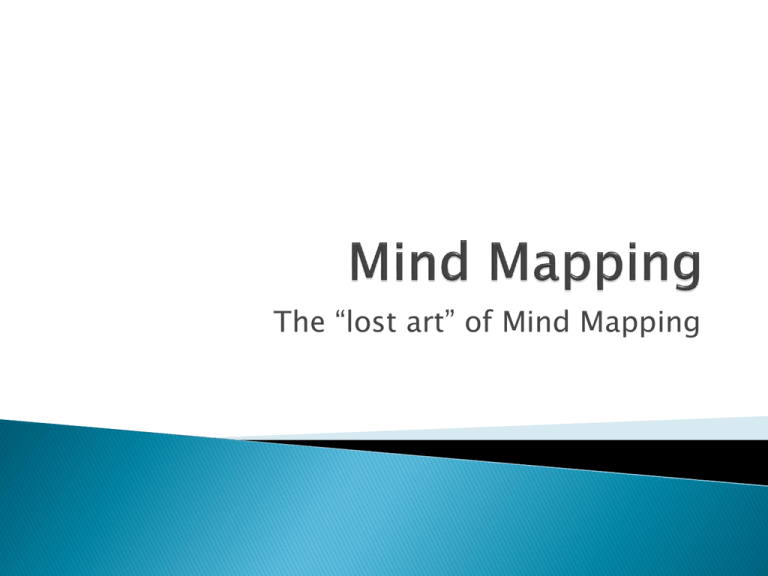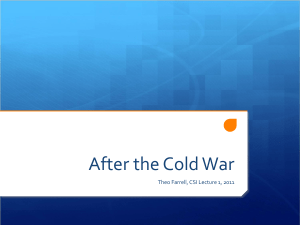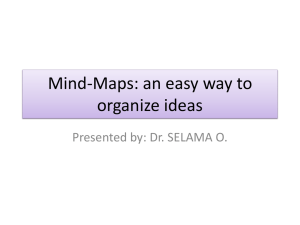Mind Mapping - SharePoint Saturday Events
advertisement

The “lost art” of Mind Mapping Liz Sundet ◦ MBA, PMP, CBAP, CSM ◦ Musician: Percussion Piano Dog Lover: ◦ Biker: “Throttles, not pedals” ◦ Email: lsundet@earthlink.net or percusn@earthlink.net ◦ Follow on Twitter: @percusn ◦ Connect with me on LinkedIn http://www.linkedin.com/pub/liz-sundet-mba-pmp-cbapcsm/17/a36/180/ Maggie Swearingen ◦ 10 years building websites ◦ 5 years with SharePoint ◦ Expertise in: IA, UX, Governance Planning, User Adoption and Taxonomy Planning ◦ Email: maggie.Swearingen@Protiviti.com ◦ Follow on Twitter: @mswearingen ◦ Connect with me on LinkedIn http://www.linkedin.com/in/mswearingen …not quite a Mind Map Why is it the lost art: Few people have heard of it, fewer have used it in a business application What is Mind Mapping What are some guidelines around Mind Mapping Create a Mind Map How to apply Mind Maps to business Demo – we need an audience guinea pig! First learned Mind Mapping during an MBA class It fit my learning style by combining a kinesthetic learning (doing learner) with a visual learner in a very creative way I’ve used it in a variety of ways and get asked often “what are you doing”? What is Mind Mapping ◦ Graphic diagram to visually outline information ◦ Created around a single word or text to which associated ideas, words and concepts are added ◦ Can be drawn by hand or used with software ◦ Also called spider diagrams, spidergrams, webs, mind webs, webbing or idea sun bursting Very easy to use and teach others to use it and facilitate use during meetings First popularized by Tony Buzan, a British popular psychology author and TV personality (1970’s series called Use Your Head) Version of a concept map, but a mind map uses one central key word with radiating concepts http://ts1.mm.bing.net/th?id=H.45557 45972650188&pid=1.7 http://etjune.brochure.examtime.com/files/2012/1 1/How-to-create-a-mind-map-mindmap.jpg Buzan suggests the following guidelines for creating mind maps (from Wikipedia) ◦ Start in the center with an image of the topic, using at least 3 colors. ◦ Use images, symbols, codes, and dimensions throughout your mind map. ◦ Select key words and print using upper or lower case letters. ◦ Each word/image is best alone and sitting on its own line. ◦ The lines should be connected, starting from the central image. The central lines are thicker, organic and thinner as they radiate out from the center. ◦ Make the lines the same length as the word/image they support. ◦ Use multiple colors throughout the mind map, for visual stimulation and also to encode or group. ◦ Develop your own personal style of mind mapping. ◦ Use emphasis and show associations in your mind map. ◦ Keep the mind map clear by using radial hierarchy, numerical order or outlines to embrace your branches. www.kootation.com/art-mind-maps.html Highly creative—but with a systematic purpose When doing Mind Mapping, others will be very interested in “what are you doing” Use colors, use shortcuts, use pictures, use txt wrds and anything else that allows you to tell the story in the end Start in center, upper right has 1st idea, then carry thru clockwise to other ideas Practice it! SharePoint is highly hierarchical SharePoint relies on logical relationships It’s a friendly translation from a folder-driven system Items – Documents, Images, Pages, List items Lists and Libraries Metadata Content Types Sites 350,000 pieces of content Subset of 65,000 600 sites One content type No managed metadata Highly visual Very specific Easy to update/change Exportable in a variety of formats How would someone want to search it? How is it currently organized? What’s the current folder structure? How would I want to categorize it? Who is it for? Should it be categorized by year or date? What makes my content special? ◦ Videos ◦ Webinars ◦ Press Releases ◦ White Papers ◦ Products Mid-sized organization Public facing SharePoint Upgrade Highly-categorized content Site efficiency depended on faceted search and aggregation Common ones are ◦ ◦ ◦ ◦ ◦ ◦ ◦ ◦ MindMeister MindJet SimpleMind Total Recall MindNode iThoughts iBrainstormer iMindMap (Tony Buzan’s) Termsets Terms Synonyms Relationships (Reuse?)





